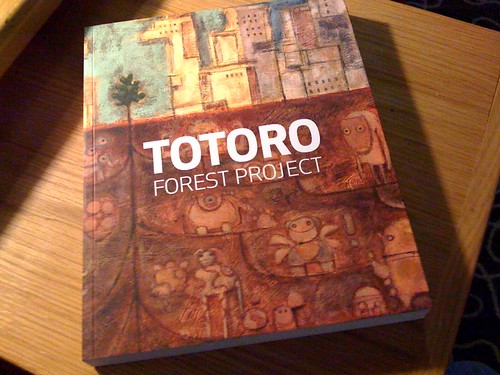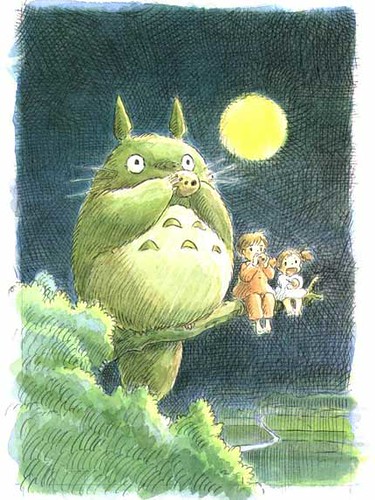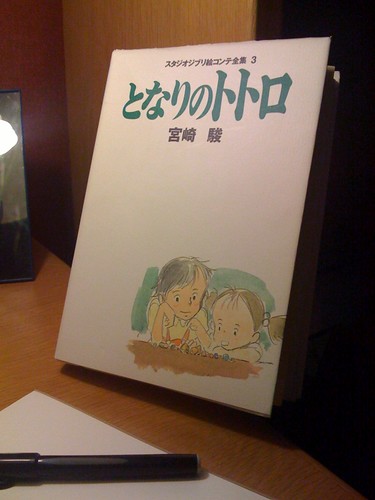
This is the auction catalog of the recent benefit show held at Pixar-a beautiful book in its own right.
Barrier invites and facilitates discussion of his views and will often reconsider a position he takes based on the feedback he receives, even if it's only to clarify or amend his original thoughts. That's a rare virtue in my book--one I hope I can cultivate better myself.
So here's my email excerpted. Do go and peruse the page it's taken from.
Dear Mike,
I thought I'd offer a few thoughts about Miyazaki's films, as mine differ from yours—most drastically as regards Totoro.
I'd never heard of Miyazaki or seen anything of his until Glen Keane (then teaching the upperclassmen at CalArts—I was a first year, but he made his lectures open ones) brought a clip from Totoro to screen. It was the scene of the girls waiting for their father; it grows dark, and begins to rain. First Totoro, then the catbus shows up. He showed this, saying that it had affected him profoundly (as I recall, the film had been screened for the Disney animation dept. the week before; I don't know if Miyazaki was there also, but I doubt it). It affected all of us profoundly, too. I was blown away by it. Me—hardly a fan of the anime I'd seen up to that point. A wordless but beautifully constructed encounter, with all facets working perfectly. I'd gather that you'd disagree, from your remark that Totoro "suffers for the opposite reason, an almost total sacrifice of action for atmosphere."

Every reaction to film is personal and often unique, of course, and I've come to various impasses with friends I respect: where one finds something sublime, the other sees kitsch, or worse, in the same thing. That's human. But I'm surprised to find you so (apparently) bored and unsatisfied by Totoro; to me, the atmosphere, the attention to detail of setting and mood, brilliantly supports and gets over the story, which admittedly isn't a "big" one: two sisters adapting to and solaced by nature, real and (possibly) imaginary. I see no lack of action—both physical and emotional. The film's full of scenes where the action and cutting are far from slow: running around exploring the empty, strange new house in the country; flying across the countryside with Totoro; riding the catbus; searching frantically for the possibly drowned Mei…and all these are interwoven with and spring from the story—not, to touch on your other recent discussion, "set pieces." Truly, what Totoro has that makes it work so well is what so few of any sort of American films—animated or not—often lack, to their detriment: carefully planned, wordless places to breathe and to really be visually hypnotized to believe in the story-world in the way film can do—better than any other art form.
As for the character animation—well, there's no question that it is coming from a very different esthetic from our American model. Yet the rough sketches Miyazaki does of all his characters (published in the "Art Of" books available for his films) are as well-realized and expressively gorgeous as anything any animator would have done at Disney's in the fifties; I can easily imagine [Marc] Davis and even [Milt] Kahl giving him his due as a sensitive draughtsman of people as well as things. I'd think he could master what we call "full" animation if he chose, but that's not his style. Yes, the lack of expressive distortion (or lack of a better word—and I'm sure there are better words!) in his characters' faces is obvious; but I've never not known what they are thinking. How that works, I think, is precisely by the cumulative effect of everything from his framing, to his cutting to the characters' silhouettes. All adds up—even if "we" would never do it that way, or try to.
I'd agree that there are definite "stock" figures in his oeuvre, but I don't agree that every heroine is the same. Perhaps as to that, though, there is something symbolic there for Miyazaki in these young girls particularly (I believe he's written on this subject, actually)—and certainly in Japan children and in particular young women hold a special place in anime and culture. I'm not qualified to comment too much on that. But just as a bystander, watching the films as pure entertainment, I've been totally satisfied by Totoro, Kiki's Delivery Service, Spirited Away, and to a somewhat lesser extent ("lesser" where his studio is concerned still indicating a high level of interest) the rest of his projects.
-Jenny Lerew

the book of Miyazaki's storyboards for Totoro






7 comments:
I couldn't agree more with your opinion on Totoro and Miyazaki!
Miyazaki does something 99.9% of anime and 100% of Hollywood corporate films can't achieve: his stories showcase creation rather than destruction (with the exception of "Princess Mononoke" which has story problems in its denouement).
Actually, Totoro is the only Miyazaki I like. The rest, ehh.
Jenny,
I really agree with your comment about the great use of quiet moments in Miyazaki's films. Wordless places to breathe ... It's one of the things I appreciate and think it can be quite powerful when used properly.
My goodness, I never saw a quiet moment in Totoro, there was always something going on. It's good to have a film where you can relax and breath in the atmosphere. I have very few American animations in my collection, they all seem to keen on getting a laugh, or blowing things up.
I like how Miyazaki's films are about growing within, Totoro, Kiki and Spirited Away in particular, and in a different sense Howls Moving Castle.
I like how Spirited Away has no bad guys in it. There are some who scare us at first, but once we get to know them, they are decent at heart.
I like the flowing textures in his fields and trees. I like his attention to detail, though that is far more evident in his manga.
I guess you have already heard of Osamu Tezuka. If not, try and find a copy of "Buddah" by him, it doesn't matter which volume, after a few pages of simple, toony looking characters (with amazing faces) you will find a richly texture mountain or forest of cloudscape.
It's always great to read what animators and artists think of Miyazaki and Ghibli. There isn't enough writing by you guys as far as I'm concerned. I'm always so curious as to what you think. I'd probably be the one to show up at a public appearance with a stack of art books and a hundred questions.
I remember that Totoro's quiet pacing was a bit of a hurdle when it was first shown in the US (Siskel & Ebert had one of their famous fueds over this movie), but I think that says far more about American culture than anything else. Ours is a culture wrapped around bam-bam-pow, instant gratification, and endless stimulation. And, to a greater extent (as I touch gracefully upon politics), the American Empire itself. Miyazaki exists in a different world than ours.
I don't suppose there's any way I could get a copy of that auction book? It certainly looks great, and it's for a good cause (the Totoro Forest Project).
great article! Totoro is probably one of the most inspiring movies I know and it's fun to read the way you think about the style and story telling.
good stuff!
Post a Comment